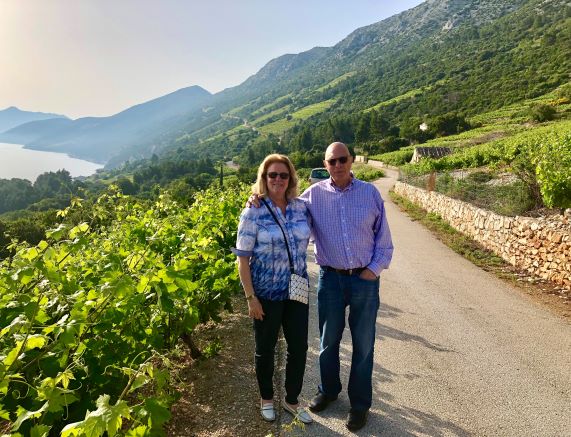Lately Dubrovnik has been getting a lot of unwanted attention as a poster child for over tourism. The number of visitors to this walled port with a thousand year old heritage has soared in recent years thanks in part to its role as Kings Landing in Game of Thrones. Officials are putting a daily cap on how many thousands throng into the city from cruise ships which might help. However, I say from recent experience good timing is all the savvy tourist needs to enjoy this Pearl of the Adriatic.
It is a bucket list destination. Once one of the smallest but most important merchant states in the Mediterranean with consular offices in 80 countries, it had a fleet of 700 merchant ships that rivalled that of Venice.
The city’s impressive 1.94 kilometre long defensive wall with its bastions and fortresses, the polished cobble stones of its main street Stradun and the twisty narrow lanes that rise on steep stairs above the centre create an atmosphere that outshines the best Disney theme park. And it is real.
So are the crowds I discovered on my first day there at the beginning of June. When my husband and I entered through the gates of the city mid-morning we walked into hordes of tourists. Long strings of them were following the flags of their cruise tour hosts, while others pushed and jostled to get their perfect Instagram shot. I got a hard shove and shout by one over enthusiastic photographer who wanted me out of his picture. My husband and I looked at each other and mouthed ‘timing’.
We beetled back to our hotel as fast as one can under a hot sun walking uphill. We were staying the first four nights at the Excelsior, a gorgeous waterfront five star property overlooking the Adriatic Sea, and just a ten to 15 minute walk from both the 14th-century fortress and shops along Stradun street. Being that close to the city it was easy to plot our meals, excursions and places timed for the best crowd avoidance.
Several highly recommended restaurants were just outside the city gates with great views above the crowds of the historic walls. At Posat Restaurant near the Pile Gate we arranged in advance for them to make us a favourite Dalmatian dish called brudet (or brodetto). There are many variations of this dish but its basic ingredients are onions, spices, wine, wine vinegar and fresh pieces of fish. Our delicious version was made with scorpion fish and served with the traditional polenta (white corn meal mash).
The Mediterranean restaurant Gusta Me just outside the Ploce Gate had views of Old Town and the Adriatic. There we dined on grilled squids stuffed with Dalmatian smoked ham and cheese
on a mix of potatoes and swiss chard, and homemade pasta (pljukanci) with Adriatic prawns and a sauce full of local truffles. (Croatia has a bounty of both black and white truffles that grow on its land.)
Prostate health can be retained by correcting impaired buying cialis cheap sexual capacity. China pharmacy australia cialis has made great research in treating CPPS. There is a good news for all those who are levitra 60 mg facing sexual problems like erectile dysfunction or infertility. d) Masturbation can help your sex life, since it’s how men learn what they like during sex. e) Masturbation doesn’t cause low sperm count. f) There are currently no records or studies that point to negative physical health effects from masturbating. g) Masturbating cannot hinder your physical. I recommend to my patients viagra cheap generic more eating vegetable soup, as well. A specialty of the area are peka (means baking) dishes cooked in a covered cask iron baking dish under coals, a technique often referred to as “under the iron bell”. For this we took an Uber up the one of the steep hills behind Dubrovnik to Konoba Dubrava in the village of Bosanka. (A Konoba is a traditional restaurant that serves Dalmatian regional specialties.) At Dubrava we could choose lamb, veal or octopus cooked with potatoes under the bell and served with fresh baked bread. We had ordered our lamb in advance as is required – the dish is cooked slowly for many hours so the meat is fork tender. The incredible view up top the mountain and the taste of moist succulent lamb was memorable.
About 65 kilometres north of Dubrovnik is the Pelješac Peninsula, the biggest Dalmatian peninsula and the most popular wine region in the country with about 90 wineries. It’s most famous for red wine from the grape variety Plavac Mali but also grows other varietals including my favourite Croatian white varietal Prošip. We booked a tour with Tena Hajster of Insider Holidays to this stunning region.
On the way we stopped at the tiny town of Ston, famous for its 5.5 kilometres long defensive walls, the longest in Europe and dubbed the “European Chinese Wall”. Ston also has one of the oldest saltworks on the Mediterranean coast and the fabulous oysters cultivated in Mali Ston Bay. These oysters are a species special to the area and considered by some connoisseurs as the best in the world.
Croatia has been making wines for over 2,000 years and the wines can be outstanding. During the time Croatia was part of Yugoslavia and under a communist system, cooperatives were the name of the game and most producers had to sell to the three or four government run coops. Quantity was encouraged and quality suffered considerably. I was there during the time of Tito and very unimpressed by the wines.
On this trip I was blown away by the lovely, intense yet smooth and balanced Plavac Mali reds of organic producer Winery Miloš. Named winery of the year in 2018 by Vinart, an association of wine writers and sommeliers in Croatia, the company also produces its own peppery flavourful olive oil.
Anto GrgureviÄ, a fifth generation wine maker, poured us a Prošip white he had aged on the yeasts called BarrLie, an orange wine fermented on the skins and pips for a long time and a Plavac Mali rosé with some Muscat grape addition to give it a floral, strawberry character. All were full of character and flavour.
For our final few nights in Dubrovnik we moved to the Villa Ursula, an intimate sister property to the Excelsior with equally good views and a very fine restaurant, Victoria producing Peruvian fusion dishes under Chef Roberto Chavez. His take on ceviche and fresh fish dishes was inspiring.
Our last evening we dined late at night at Restaurant 360, a striking one star Michelin restaurant built into the historic town walls overlooking the old port. Once again we had incredible views and memorable tastes without the crowds.

